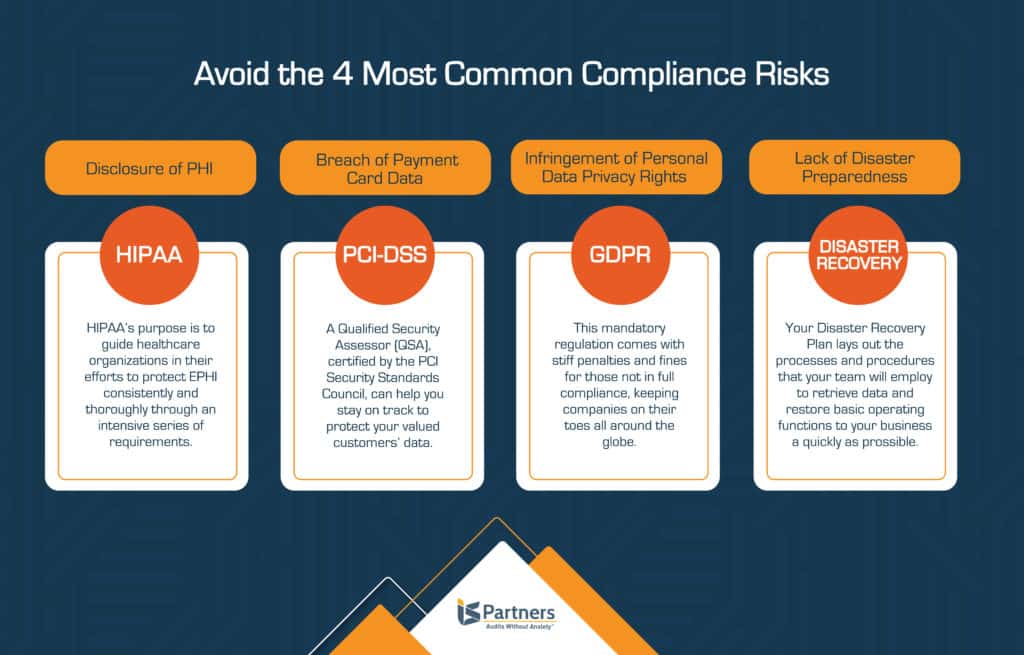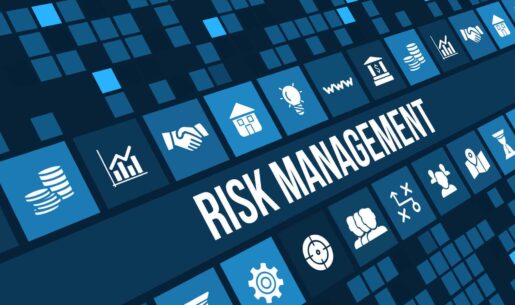Most organizational leaders simply consider regulatory compliance one of the many costs of doing business today. It’s the norm for businesses to be required to comply with at least one, if not multiple sets of regulations. There are plenty of intangible and non-mandated reasons to perform compliance-related duties. Apart from the fines and the bad press, the primary reasons that business owners willingly jump through the necessary hoops most often involve protecting their customers and their own brand.
What Is Compliance Risk?
Compliance risk is an organization’s potential exposure to legal penalties, monetary fines, reputation damages and material loss, caused by a failure to act in accordance with government laws, industry regulations, or prescribed best practices. This type of risk is present for every type of organization — public, private, for-profit, nonprofit, state and federal.
Avoiding compliance risks involve staying on top of your industry’s specific legislation regulatory bodies, as well as state and national standards. Bodies like the Occupational Safety and Health Administration (OSHA) and the Environmental Protection Agency (EPA) regularly deploy regulation updates to a range of different industries while the Health Insurance Portability and Accountability Act (HIPAA) serves as an example of a complex and often-changing set of laws specific to one industry.
Why Compliance Risk Is a Real Threat
Besides punitive fees, penalties and a sense of professional obligation, there are additional reasons to make your best effort to avoid common compliance risks, which include:
Legal & Liability Concerns
Any failure to comply or outright negligence may result in further legal troubles for your business. Compliance helps you to avoid additional legal issues that include work stoppages, lawsuits that could result in the ultimate shutdown of business, and hefty legal fees.
Data Security
Many times, regulations and standards provide insights into your industry that serve to help you sharpen your business operations. PCI, HIPAA and GDPR are just a few regulatory bodies that monitor all the latest in risks that could affect consumer data. By maintaining regular compliance, your organization is automatically implementing the latest protections against data breaches and other risks.
Business Reputation
Experiencing a breach, or receiving a fine for non-compliance, can be a huge blow to the upstanding reputation that your brand has worked hard to build. Customers and industry peers will have doubts about doing business with your organization for years to come.
Any time you can let stakeholders know your organization is fully compliant with all relevant standards, it’s good for public relations. Each time you bring in a professional auditing team and receive authoritative certification, you can place that information on your website to let everyone know. And this works towards retaining, and earning, trust and loyalty.
4 Most Common Types of Compliance Risk
Every modern business, regardless of industry, faces a certain degree of risk. Risk has always been intertwined with any type of business endeavor, and good business leaders have adapted to risk related to their business by understanding it and finding ways to combat it.
The need for risk management has never been greater. Leaders in areas like healthcare and the credit card industry have taken note over the past several decades. Likewise, governing bodies have developed compliance standards to help organizations avoid and mitigate risk.
- Disclosure of PHI
- Breach of Payment Card Data
- Infringement of Personal Data Privacy Rights
- Lack of Disaster Preparedness

Disclosure of Protected Health Information (PHI)
Many of the common violations to HIPAA regulations involve the organizations not performing the right risk analysis and procedure reviews to ensure patient information is kept secure. Security protocols need to be implemented for compliance and to prevent the mishandling and misuse of electronic patient information.
HIPAA lays out standards designed specifically to reduce the risk of disclosing PHI.
- Misplaced Paper-Based Medical Records – Paper forms left on the receptionist’s desk can be read by other employees who should not have access to this information, or by other individuals. All paper-based records need to be kept in a locked location that only allows access by authorized personnel. In addition, health organizations need to have proper medical record handling procedures to prevent the information from being misplaced in the office.
- Stolen or Lost Electronic Devices – Today, PHI is regularly accessed on smartphones, tablets, and laptops. So, medical personnel must have safeguards in place to prevent unauthorized access and viewing of this data in case a device is lost or stolen. The organization needs to develop the appropriate encryption methods for electronic devices used in the medical facility, as well as have procedures for employees to report lost or stolen devices in a timely manner.
- Unauthorized Access of Patient Information – Employees must be aware that talking about, sharing files, and taking patients’ photos can be a privacy violation of the HIPAA. If other people overhear, read or see the information, they could use it to the detriment of the patient or the medical practice. Employee training that focuses on HIPAA regulations and prevention methods to stop the inappropriate disclosure of patient information can help workers stay in compliance.
Breach of Payment Card Data
The Payment Card Industry Security Standards Council—founded and formed by major payment brands like Visa, MasterCard, American Express, JCB International and Discover Card Services—agreed to incorporate the PCI Data Security Standard (PCI-DSS) into each of their security programs. This standard has become the best weapon against relentless hackers targeting payment card data.
A Qualified Security Assessor (QSA), certified by the PCI Security Standards Council, can help you stay on track to protect your customers’ data.
Related article: the Advantage of Combining HIPAA and PCI Compliance Efforts.
Infringing on Data Privacy
After two years of preparation for companies worldwide, the General Data Protection Regulation (GDPR) took effect. The EU created a set of data privacy laws in the interest of protecting consumers’ confidentiality when making transactions in Europe and around the world.
The EU wanted to place more control of data into the hands of its citizens by developing and mandating requirement matters that include the following:
- Data Portability
- Data Breach Notification
- Data Protection for Children
- The Right to Be Forgotten
- The Appointment and Training of a Data Protection Officer
- The Easy Identification and Availability of Data Upon Customer Request
This mandatory regulation comes with stiff penalties and fines for those not in full compliance, keeping companies on their toes all around the globe. Companies that are uncertain as to whether they are subject to the GDPR may wish to consult with an auditing firm for optimal risk management.
Lack of Disaster Preparedness
Never underestimate the potential power of a natural or man-made disaster on your computer system. It is more important than ever to examine every possible disaster scenario that might affect your business in the event of a flood, hurricane, wind storm, tornado or fire.
While business continuity attends to the functioning of daily business matters in the event of a disaster, your disaster recovery plan focuses supporting IT systems that support fundamental business functions. The plan lays out the processes and procedures that your team will employ to retrieve data and restore basic operating functions to your business as quickly as possible. Although businesses are increasingly storing some portion of their data in the cloud, they must still be able to perform daily technology-based duties on the premises of their organization.
This type of plan is not only fundamental to business continuity, it’s actually required by the ISO 27031 standard and for SOC 2, NIST, and HIPAA compliance. A breach that occurs during a time of vulnerability due to a natural disaster or cyber event, could be penalized if preparation could have prevented it. Core elements of an effective disaster recovery plan include:
- Identifying known and potential weaknesses, such as a strong potential to experience flooding or tornadoes.
- Strategizing to minimize the duration of a serious disruption to business operations.
- Facilitating effective coordination of recovery tasks by developing teams for various duties.
- Simplifying recovery efforts by considering issues like potential relocation options.
- Performing test drills to identify and correct problems.
Related article: HIPAA Requirements for Disaster Recovery in the Cloud.
Build a Framework for Compliance Risk Management Success
Like any other facet of your business, effective risk management control starts by working with your management team to develop and design your organization’s shared vision, recommends KnowledgeLeader. While your company’s shared vision is often more aspirational, and even somewhat nebulous without a distinct plan of action, your risk management game plan involves defining concrete objectives, laid out in clear terms.
Organize Compliance Efforts
Your management team will lead the primary phase of risk management control, identifying and categorizing the various risks that run throughout your organization. Each team member will focus on a particular risk factor, relevant to their area, monitoring that risk and ensuring compliance with risk management procedures.
By developing a coherent and consistent framework, methodology and language for your ERM, you will build a firm and effective foundation for risk management control.
Monitor Risks and Maintain Compliance
Effective risk management control should be dynamic. Your ERM team needs to continually monitor the risks, as well as controls that you have set in place to maintain your organization’s shared vision. Some of the key factors of your ongoing ERM plan might include the following:
- Inform staff of their responsibilities and role in compliance efforts.
- Monitor business trends, financials, data mangement, and regulatory updates to anticipate new risks.
- Change activities should be handled carefully.
- Conduct regular internal audits.
Put Your Risk Management Control Plan Into Action
Risk management control is certainly challenging, but with the right plan and a committed team, you can keep your company, as well as all other stakeholders, safe, satisfied and profitable. Contact I.S. Partners for more information.
This article was originally published in 2018 and has since been modified and updated multiple times to reflect the most accurate information.

